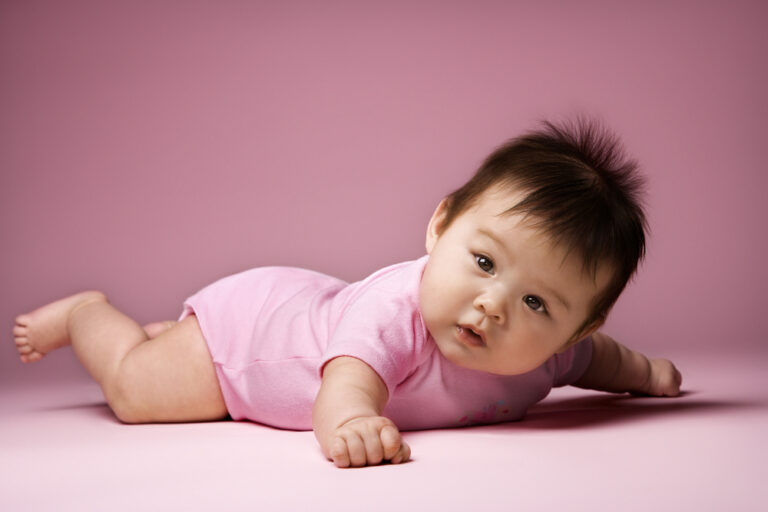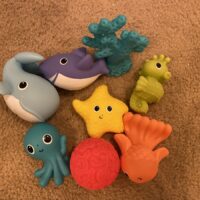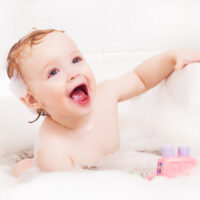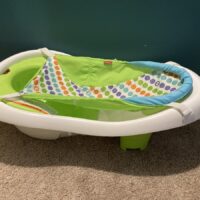Accidents are likely to happen at home, including small objects that somehow manage to get into a baby’s eye. If you’re asking yourself, ” How do I remove these from my baby’s eye?” we have a few recommendations for you. Please note that these tips are intended for objects such as dust, lint, or an eyelash. For more irritating objects, injuries, or chemical exposures, please seek medical help immediately!
Important Things to Consider
1. Do everything possible to prevent your baby from touching the affected eye. If you are alone, a great option is to swaddle your baby’s arms. Although they may not be happy about this, it will prevent them from rubbing the irritated eye. This reduces the likelihood of scratching the cornea.
2. Never touch your baby’s eye directly with your fingers or any tool. You do not want to accidentally scratch or further injure the eye. Even if you’re trying to be gentle, fingernails and other objects can be abrasive.
3. Call your healthcare provider, even if you feel that you are able to fully remove the object or irritant. He or she can advise you of the next appropriate steps, and discuss potential problems that could develop.
If a chemical splashes into your baby’s eye, flush the eye immediately with water or saline (source). While doing so, call poison control and check the bottle’s label for the accidental injury instructions. Flushing the eye as soon as possible can help prevent vision loss and long-term disability (source).
Removing an Object with a Damp Warm Cloth
First, be sure to wash your hands prior to caring for your baby’s eye to prevent the spread of infection. Then, grab a clean washcloth, and soak it in water. Ring the water out so that the cloth is damp but not dripping wet. Test the cloth on the inside of your arm to make sure it is not hot enough to cause a burn.
Second, use the warm cloth to wipe around the eye, removing any dirt or debris. This prevents additional particles from making their way into the eye. Place the warm, damp cloth over the closed eye for several minutes. The combination of heat and moisture will promote the natural production of tears. These excess tears may dislodge the debris or eyelash.
Finally, use the warm cloth to gently wipe the outside of the eyelids, then check to see whether or not the object is still in the eye. You can repeat “step two” a few times if necessary. This method is a gentle option, so hopefully, your baby will not become too distressed. Once the object has been removed from the eye, your infant should become calm and less irritable.
Removing an Object from Baby’s Eye by Flushing
An alternative is to flush your baby’s eye with water. With this method, you’ll want to prevent your infant from rubbing the affected eye. Most will not enjoy this procedure, and you may need someone to help you hold your baby. If you are alone, try swaddling their arms. As always, first wash your hands.
Below are two techniques that we suggest:
Eye Dropper Method
An eyedropper is a great way to aim a stream of water directly into the eye. If you don’t have an eyedropper, a medication syringe is a great substitute (source). If you happen to have a bottle of saline drops at home, this is a good alternative; saline can be less irritating to the eye than water.
Fill a bowl with lukewarm to cool water; make sure that it is not hot! Hold your baby over a sink or a towel. The baby’s head should lean to the side and downward to allow tears, water, and debris to flow out of the eye. Fill the eyedropper or syringe with water, then position it at an angle while gently squirting the water toward the tear duct. Water will flow from the tear duct, along the center of the eye, and into the sink or towel. This helps to remove whatever is in the eye, and stimulate tear production, simulating the effect of the “warm cloth” method.
The natural production of tears can be the most effective way to remove something from a baby’s eye. Anything you can do to support tear production is great. If tears do begin to flow, keep a clean cloth nearby to gently wipe them away. You should notice the foreign particle as comes out with tears.
Full Flow Method
This method may be more effective for removing sand, dirt, or a chemical from the eye. You can either use a full pitcher of water, or go directly to the faucet.
As before, be sure to wash your hands before touching your baby’s eye. While holding your baby over the sink, the affected eye area should face downward with the eyelids held open. This technique may be easier if you have someone to help you. It is important for both the top and bottom eyelids to remain open and accessible to the water. Your infant will not like this method, but it can be very effective.
Flush the eye with a continual stream of lukewarm (not hot) water for up to 15 minutes (source). Check every 5 minutes to see if the debris is gone.
If, after 15 minutes of flushing, the object remains, it is time to seek the help of a medical professional. In all cases of chemical splash injuries to the eye, medical attention is necessary. You do not want to risk damage to the eye.
An Eyelash in the Eye: Giving it Time
There’s something to be said about “giving it time,” even though it can be hard to sit back and do nothing! If you notice an eyelash in your baby’s eye, and they are not distressed or bothered by it, try allowing it to work itself out. Throughout the day, as your baby opens and closes the eyes, looks around, cries, etc., it may dislodge on its own.
Observe your infant, however, for any signs of concern. If you notice eye rubbing, redness, irritation, or discharge, it may be time to intervene. You can try any of the above methods to clear your baby’s eye. If these fail, call a doctor.
Final Thoughts
While it may be possible remove dust, lint, and eyelashes from your baby’s eye, it is still important to observe them, and decide if medical attention is warranted. If the eye irritation has not improved within a few hours, your baby is uncomfortable, or discharge develops, we do recommend that you contact a doctor.
Eye injuries are stressful, but simple objects in your baby’s eye are not always a medical emergency. Be prepared, however, knowing that it will be challenging for you and your baby to try to flush out their eye. There may be lots of tears involved, but tears also help dislodge foreign objects!
When in doubt, don’t hesitate to seek medical advice. A doctor can accurately tell you if your baby should be seen, and identify any concerning symptoms. Because babies can’t tell us “what’s wrong,” it’s important for us to observe and be their best advocate. Children’s Hospital Colorado provides information on when medical help is recommended.
Know that you have the strength and ability to quickly help your baby. You’ve got this!






